Houses with openwork carvings preserved from the last century can be found in many cities of our country. There are especially many old buildings with carved decoration in the Siberian city of Tomsk.
Folk craftsmen have always had a sense of proportion, so only certain parts of the building were decorated with openwork carvings: window and door frames, chapels, end boards. On sunny days, when the shadow from the slit architraves covers the smooth walls of houses with dark lace, the expressiveness of the openwork carving is enhanced. But even on cloudy days, the details of the carving stand out in a clear pattern against the general background of the wooden structure.
But not only for the sake of beauty, carpenters sewed all kinds of overhead parts to the house. Each of them has a specific practical purpose. For example, a prichelina is a board that covers the ends of the roofs sticking out from under the roof to their ends. moisture did not penetrate, destroying the tree. The end board, which was nailed to the ends, has the same purpose. log cabin. The window platband closes the joint between the window sash trim and logs. In northern Russian huts, the junction of two chapels was covered with a so-called brush, the lower end of which was decorated with openwork carvings. The so-called towels were also carved - the lower ends of the chapels protruding from under the roof.
Nowadays openwork house carving continues to be used to decorate rural wooden houses, country houses, gazebos, sheds, towers on playgrounds.
It is not so easy to create an original ornament anew, so much of the traditional ornament remained unchanged for many years. Only individual talented craftsmen introduced new elements into it, improving and honing every detail. Ordinary craftsmen usually used ready-made templates, and previously built houses served as samples, so there was no need to draw up a sketch.
Modern light wooden buildings, such as gazebos, sheds, playground houses, do not have standard proportions that have been adjusted for centuries. Therefore, for each such building, it is imperative to develop sketches using pre-collected material: photographs, sketches of buildings with expressive carved decoration, individual fragments of architraves, end boards, and piers. All this can be collected on hikes, during excursions around the native land. In cities where the old ones are demolished wooden houses, you can collect a rich collection of carved architectural details. Usually they irretrievably disappear along with construction rubbish. Of course, photographs, drawings, carving samples are not collected in order to one-for-one transfer beautiful patterns to your sketch. The main thing is to try to understand by what means the folk masters achieved expressiveness. wooden ornaments, to feel the originality and beauty of openwork carving, to note the features of the patterns that exist in your area. Only after that you can start working on sketches.
On a sheet of paper, first of all, draw general form, side view and facade of the building with a conventional image of openwork decoration. The main task solved in such a sketch is to find an expressive form of carved details, to determine the relative proportions in relation to the entire structure. Then, guided by the sketch, complete each decorative detail separately, showing its design and the nature of the proposed ornament. Based on the developed sketches, draw each detail in full size on wallpaper paper. We will tell you how to make templates according to the working sketch, with the help of which the drawing is transferred to the material, after you prepare necessary tools and material.
To perform openwork carving, you will need ordinary carpentry and carpentry tools, and when finishing, carving tools.
The main tool used for drilling holes in the board is a brace. They usually drill large holes. It is reliable, proven in work carpentry tool. A ratchet with a ratchet is more convenient, which allows you to lock the cartridge by turning the ring and change the direction of its rotation when clamping or releasing from the drill.
Holes with a diameter of 10 mm or more are drilled using special flat drills - perok. In addition to ordinary perks, there are universal ones with removable cutting plates on sale. The kit includes 7 drills with a width of 14, 16, 18, 20, 22, 25 and 32 mm. If it is not possible to purchase flat drill bits for wood in a store, you can make them yourself. Make plates with cutting edges from an old saw blade 1.5-2 mm thick, which can be processed quite easily with a file. When cutting, the canvas is broken according to the applied deep risks. The risks are applied with a scraper, file or some other tool from solid metal. Make a holder from a bolt or rod with a diameter of 8 mm. Having fixed the rod in a vice, make a cut from the side of the end with a hacksaw for metal. Drill a hole perpendicular to the cut. Punch a hole in the plate at an appropriate distance from the top edge. Connect the plate to the holder with a rivet. If you want to make the holder universal, cut a thread in its hole and select the appropriate lock screw. The universal holder is constantly clamped in the chuck, and when drilling holes of different diameters, only drill-plates are changed. Before drilling, the center of the future hole is marked with an awl.
Small holes are drilled with a drill or drill. If you are unfamiliar with a drill, look at the picture where it is shown.
Often, openwork carving is called sawn carving, since its technique is based on sawing figured openings in the board. Saws for sawing curved blanks along the outer contour are called rotary or circular. The width of the blade of the circular bow saw is from 4 to 15 mm. Narrow blades are used when cutting blanks with steep bending lines, and wider blades are used in large ones with smooth, slightly curved or straight contours. Unlike a conventional joiner's bow saw, the blade must be rotated. This makes it possible to make cuts in different directions, almost without changing the position of the saw machine. The circular bow saw machine can be made by yourself from birch or beech wood. Depending on the size of the workpieces you are sawing and the length of the blades you have, bow saws can have a wide variety of sizes. The circular saw consists of two racks that are inserted into the eyes hollowed out in the thickened ends of the strut. Holes are drilled in the lower parts of the racks, into which they are inserted lathe pegs. The handles should rotate with some effort. On the opposite side, at the end of each handle, longitudinal cuts are made into which the canvas is inserted. The tension of the canvas occurs due to the twisting of the bowstring, which tightens the upper ends of the spacers. The bowstring is made from 10-1 2 turns of hemp or linen twine. Instead of twine, a rod with a thread cut at both ends is also used to tighten the upper ends of the racks. The rod is passed through the holes in the racks and, having put on metal washers, the wing nuts are screwed on both sides. The stands of a homemade circular saw are usually made elongated - this makes it possible to cut curved lines at a considerable distance from the edge of the board. And the saw blade, along with the spacer, is shortened. Such a saw is much more convenient to work with than a standard saw.
All saws basically have three types of teeth: isosceles, rectangular and oblique. If the saw is intended for sawing wood across the fibers, then its teeth should be isosceles triangles, if along, then inclined. The circular saw, moving along curved lines, crosses the wood fibers at various angles. What kind of tooth shape should a circular saw have? The most versatile was a saw with a rectangular tooth shape, when one of its edges is located at a right angle to the blade. To increase the maneuverability and ease of movement of the circular saw, the set of teeth must be made quite large.
Curvilinear blanks from boards with a thickness of not more than 10 mm are cut with a small round saw or jigsaw.
In production, curved blanks are sawn out on band saws. The blade of such a machine is a flexible steel tape with welded ends. Maybe you want to make such a machine - its diagram is shown in the figure.
Remember that when working on a band saw machine, you must strictly follow the safety rules. The saw blade must move in the guard. Accidental start of the machine must be excluded, for which the button is covered with a hinged lid. And most importantly - when working, keep your hands away from the saw blade!
The main tool for sawing out internal openings in the workpiece is hacksaws with narrow wedge-shaped blades, the so-called triggers. Triggers can also cut blanks along the outer contour. In addition to the usual triggers of different sizes, universal ones with removable canvases are used. The thickness of the blades of the triggers is 1.5 mm, the length is 325-530 mm, the width at the handle is 20-40 mm, the shape of the teeth is rectangular. The saw is bred through one tooth: even teeth to the right, and odd teeth to the left. They sharpen at random, that is, first through one tooth on one side, and then, turning the canvas, on the other side.
If the hammer could not be bought, it is made by hand from an ordinary hacksaw or an old saw blade 1.5 mm thick. The hacksaw blade is cut so that an elongated sharp wedge is obtained. If the teeth of the hacksaw you are using have rectangular shape, then the excess metal is cut off from the side of the butt, but if they are of a different shape, then you need to cut off that part of the web on which the teeth are located in order to cut out new teeth on this edge later. You can cut the canvas as follows. Clamp the blade in a vise between two planks so that only the part that needs to be cut protrudes. Run the tip of the scraper several times along the edges of the boards on the canvas until a sufficiently deep risk is formed. Apply the same risk on the other side of the canvas. Then, with hammer blows, bend the protruding part of the canvas. Usually the canvas breaks easily exactly at the risk. Align the resulting rough fracture with a file. The trigger blade will move more freely during the sawing process if it is planed, that is, the metal is filed from the butt side with a file. Strengthen the canvas with clamps on the workbench. In order not to inadvertently touch the teeth with a file, nail a metal plate 3-4 mm thick along them on a workbench. First, with several passes of the file, remove the metal from one side of the blade, and then from the other. Usually, before planing, the cross-section of the saw has the shape of a rectangle, and after it, it has the shape of an acute triangle or a highly elongated trapezoid. When sawing, the butt of such a blade is not clamped by wood fibers and the saw moves easily in the cut. The wider the cut formed by the saw, the easier it is to change the direction of the blade. This is especially necessary when cutting sharp bends. To get a wide cut, the saw blade is well bred.
For openwork carving, boards 15-25 mm thick from aspen, pine, birch and alder are used. Because on outdoors birch wood is affected by fungi, carved from it openwork patterns must be covered with a protective layer oil paint. When choosing a material, it is necessary to harvest well-dried boards without cracks, warping and with a minimum number of knots. The smooth surface of the boards is obtained by planing.
Usually, any saw pattern consists of several repeating elements. For each of them, you need to cut a full-size template from thick thick cardboard, textolite, plywood. Soak a cardboard template several times with drying oil and dry for a day. Our drawing shows a pattern of a 5-shaped curl - the most characteristic element of house carving. Suppose you want to cut out a pattern in which the curl is repeated four times. Place the template on smooth surface board and circle with a pencil. Then move it and circle it again. Do this twice more. So you can get an ornament of any length.
Poke the centers of future holes with an awl. Immediately before drilling, fix the board on a workbench. To prevent the edges of the holes from chipping at the bottom of the board, place a thick plywood or board underneath. At the beginning of drilling and before its completion, the handle of the brace must be pressed without much effort. This will reduce the likelihood of chipping wood on the front and back surfaces of the board. It is necessary to constantly ensure that the drill is in a vertical position.
When you have finished drilling, remove the clamps and start cutting out the curved internal contours with a hammer saw.
When sawing lines with different steepness, different sections of the canvas alternately participate in the work. Very steep lines with a small radius of curvature are cut with the tip of the hammer, that is, its narrowest part. As the steepness of the line decreases, the middle part of the saw enters the work, and if the line being cut is almost straight, the wide part of the saw located closer to the handle is included in the work. After cutting out the openings on the carved board, eliminate all sorts of flaws and inaccuracies with a narrow-bladed knife and chisels.
On this, in fact, the work can be completed. But if there is time, desire and skills in handling carving tools, openwork carving can be given a sculptural form, revealing more figuratively individual details of a floral ornament.
openwork carving on wood was used by Russian carvers in ancient times. The openings in the board, decorated with a relief ornament, complemented the ornament. Openwork or patterned openings were made with a simple carving tool. Sometimes they were just round holes made with a brace.
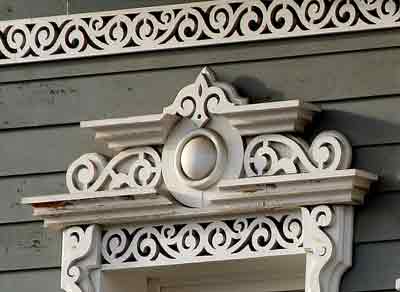
In the middle and in the second half of the 19th century in Russian wooden buildings, both in rural and urban areas, has become widespread openwork saw carving, performed using a thin file - a jigsaw. In many cities and villages of the European part of Russia and Siberia, entire streets of houses are still preserved, the pediments of which, window trims, and entrances are richly decorated with openwork sawn carving. Openwork carving is very effective, it looks like wooden lace. Many ornamental and decorative motifs of the Russian deaf relief carving: solar sockets, usually placed in the very center of the gables or in the center of the window casing; images of birds, roosters, ducks, swans; Images different kind fantastic creatures, conditionally called "dragons" - half-birds, half-animals, with flourishing, that is, turned into leaves and shoots, torsos and tails. There are also conditional, generalized, geometrized images of female figures in sawn carving, very similar to similar images in Russian folk embroidery and lace.
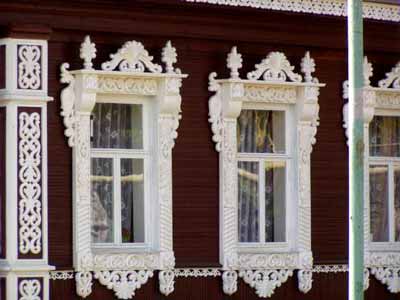
Despite the widespread use of new materials in modern urban and rural construction, sawn openwork carving still attracts builders and carvers in the construction of new buildings both in the countryside and in the city. Many buildings in the Yaroslavl, Penza, Ulyanovsk and Moscow regions are decorated with openwork sawn carving. In the best examples of this modern carving, you can see the same sun disks, the same birds and dragons.
A modern master carver, who is fond of sawn carving, should avoid grinding, overloading, far-fetched abstract forms in it and equal to the best examples preserved in nature and recorded in books and albums.
Openwork carving. on wood. Openwork through woodcarving - a variety artistic processing wood, in which the background is completely selected, and only the image itself remains, which makes it similar to three-dimensional carving. In Russian peasant art, this type of carving is widely used, primarily in home decor and household utensils.
To perform openwork carving of small household items and furniture parts, as a rule, hardwood of linden, birch, aspen in larch and pine architecture is used. From the middle of the 19th century, sawn decoration began to be intensively used in Russia, covering lush pediments and platbands. A wide range of ornamental themes of openwork carving from the simplest geometric shapes to images of people and animals is used in the countryside and by modern builders Artistic woodcarving.
Artistic woodcarving has been known since primitive times among almost all peoples in different parts of the Earth. With the constant improvement of labor tools, with the transition from stone cutters to metal tools, craftsmen mastered new technologies, more and more artistically advanced types of carving. Since ancient times, being one of the most important areas of folk art, carving still makes up a significant part of traditional artistic crafts.
V Ancient Russia wood was the most widely used material. Due to the relative cheapness and poor durability of the material, only a small part of the ancient works of decorative and applied art made of wood have survived to this day. On the basis of written sources and the few surviving monuments, one can judge the art of ancient Russian joiners and carpenters, whose craftsmanship dates back to the art of the ancient Slavs and other peoples who inhabited the territory of modern Russia, which was reflected in the techniques of carving and drawing the most archaic ornaments.
In close connection with wooden architecture, a culture of decorating utilitarian objects developed, in which technological methods and the nature of ornamentation of house carvings were preserved. Weaving mills, sleighs, wooden utensils, spinning wheels and other household items were generously covered with geometric ornaments, which in the past had a certain sacred meaning.
independent region folk carving was a wooden toy dolls, figurines, horses, teams. Wooden Toys were made in all forest regions of Russia, most of them signed. Based on the study of the techniques and stylistic features of Russian folk carving, the efforts of artists and collectors at the end of the 19th century created the so-called Abramtsevo-Kudrinskaya carving, which continued the traditions of flat-relief carving.
Today, the traditions of Russian flat-relief and geometric carving are widely used by masters and artists of old craft centers and newly created workshops.
End of work -
This topic belongs to:
The specifics of Russian folk ornament
Performing the task of decorative value, it often plays the role of a social, gender and age mark, ethnicity, is a means ... It is appropriate to recall social function ornament at different peoples. For example, ... The word ornament is derived from the Latin word ornamentum, which translates as decoration. He is not…
If you need additional material on this topic, or you did not find what you were looking for, we recommend using the search in our database of works:
What will we do with the received material:
If this material turned out to be useful for you, you can save it to your page on social networks:
Artistic carving is one of the most famous and oldest ways of wood finishing. Woodcarving can be done in different techniques.
Openwork or through woodcarving
Artistic finish of wood, in which only the image itself remains, without a background. A subspecies of openwork carving is an overhead carving - an ornament, performed in the technique slotted thread, then attached to the finished background.
Photo 1 - Openwork or through thread
Geometric carving
A type of carving art in which the desired pattern is formed using many figures (often a diamond is used). Fancy geometric patterns are an important part of oriental woodcarving. The cradle of an oriental look wood carving most likely is Egypt.
Photo 2 - Oriental woodcarving
Relief carving
The image of the product is located above the background, or at the same level with it. In this technique, carved panels are made - a three-dimensional wooden image.
Photo 3 - Carved panel "Lion"
baroque carving
Flat-relief carving, the main difference of which is the abundance of carved and stucco decorations, bizarre curls, images of people in unnatural poses, curved leaves, various colors, fantastic animals.
Photo 4 - Fragment of baroque carving
Carved balusters transform even the simplest staircase. Balusters - figured columns in the form of columns, elegant decoration of stairs.
Wooden balusters will look organically with a screw wooden stairs- a very beautiful, comfortable and popular staircase for small spaces.
Photo 5 - Spiral staircase, carved balusters.
Kudrinskaya
Relief carving that originated in the village of Kudrino. The main decorative role in this carving is played by floral ornament: twigs, rosettes and curls. Famous products of this carving are dishes, vases, ladles, caskets, home decor items.
Photo 6 - Kudrinskaya woodcarving
Volumetric thread
It is also called sculpture. This technique is used to make toys, sculptures, figurines, etc.
bas-relief
Decorative modeling, sculptural image on the plane. Another name for "low relief". Most often, bas-relief images are figures of people and animals.
Bogorodsk carving
A subspecies of volumetric carving, a three-dimensional image of something. The Bogorodsk toy is the most famous example of this technique. These are wooden figurines of animals and people, the main folk craft the village of Bogorodskoe near Moscow. For such carving, soft woods such as linden or alder are best suited.
Photo 8 - Bogorodsk carving
Japanese carving
Beautiful wooden crafts, called miniature sculptures, in which small things were kept. For example, okimono - "carved figure", a figurine, is designed to decorate the interior.
Photo 9 - Japanese woodcarving
Scandinavian carving
Ancient artistic carving, wooden Scandinavian churches were decorated in this technique. Outside and inside, such churches were decorated with traditional ornaments, mythological motifs, mainly images of Gods and various animals.
Photo 11 - Landscape
Types of woodcarving are rather conditional. Each type of carving requires special preparation, as well as the choice of wood, carving technique.
Each nation has its own culture, way of life, traditions. But they all have one thing in common - the desire for beauty. And if the ancient man, when arranging housing, had the only goal - to hide from bad weather and wild animals, then with the transition to a settled life, priorities change: the development of science and culture leads to the arrangement of life, housing is decorated. The development of crafts in a particular area depends on the availability of materials and fossils. So, in the region of the northern seas, where the main industries are fishing and hunting, walrus bone carving is born. Blacksmithing is developing in mountainous regions with large reserves of ore. Forest regions are rich in timber. It has long been used for housing construction and home improvement. ending field work, peasants, to pass the long winter evenings, are engaged in woodcarving. Over time, an exciting hobby turns into a main craft. Many achieve this unprecedented skill. Products of masters have the right to compete with the works of famous artists. And why compare? With the help of a simple tool and imagination, the master's hands create unusual and rare masterpieces from the most ordinary wood. Artistic woodcarving is a truly unique phenomenon.
Wood carving: main types
Over time, this type of applied art has not only not lost its popularity, but, on the contrary, has been developed. Depending on the type of materials used and the way they are processed, new types of woodcarving are distinguished: relief, flat-relief, sculptural, flat-notched and sawn. The main difference is the location of the pattern in relation to the surface or background of the work. Each of these types has its own methods of implementation, tasks and end results. Let's dwell on each of them in more detail.
Saw thread
This is one of the carving methods, when the background is completely removed from the canvas. It has other names: slotted or through woodcarving. 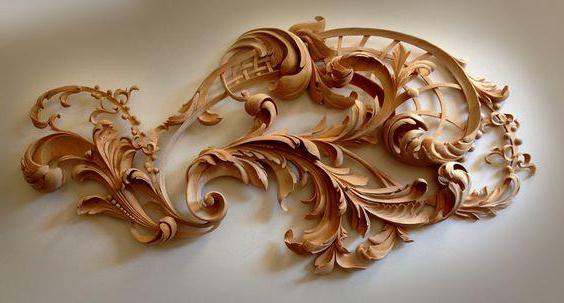 This term accurately describes the woodworking process. Fits perfectly here geometric carving and relief. This is one of the oldest techniques, it requires a certain skill and skill, such as openwork through carving. The technique here is as follows: the workpiece is fixed, lined, the main drawing is applied and holes for the saw are drilled. Along the contour, filing is carried out and the subsequent preparation of the material for work: chamfering with a chisel and cleaning the workpiece with sandpaper. The effect of airiness, lightness, weightlessness is created. The work is so fine and delicate that it is sometimes hard to believe that wood was used.
This term accurately describes the woodworking process. Fits perfectly here geometric carving and relief. This is one of the oldest techniques, it requires a certain skill and skill, such as openwork through carving. The technique here is as follows: the workpiece is fixed, lined, the main drawing is applied and holes for the saw are drilled. Along the contour, filing is carried out and the subsequent preparation of the material for work: chamfering with a chisel and cleaning the workpiece with sandpaper. The effect of airiness, lightness, weightlessness is created. The work is so fine and delicate that it is sometimes hard to believe that wood was used.
relief carving
All types of woodcarving differ in their relation to the background: it is either absent, or is in the same plane with the pattern, or is recessed a few millimeters inward. The background is the surface of the products, which is decorated with geometric shapes or floral patterns. In this case, it is removed around the surface of the pattern and cuts 5-7 millimeters deep into the canvas. The work is carried out in such a way that the background and the drawing are both in the same plane, but at the same time they look voluminous, and in different ones: the drawing rises above the background due to the recesses along its contour, but at the same time all the details are at the same height. In this style, figures of people, animals and birds, elements of the plant world are usually depicted. It all depends on the idea of the master and the technique of execution. Most often, flat-relief carving is used in architecture and applied arts.
relief carving
All types of wood carving require a certain skill and skill. You need to start with the simplest patterns. In order to correctly understand the essence of each element, it is better for a beginner to reproduce all new and more complex details from plasticine, and then proceed to wood processing. This also applies to relief carving. 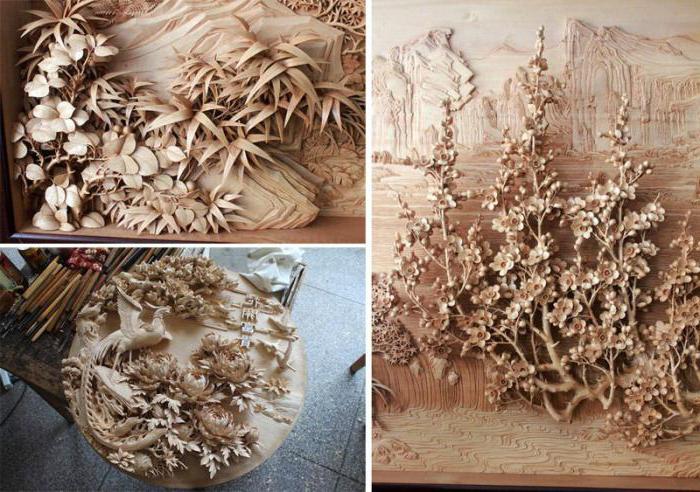 It is rightfully considered the most picturesque. This is a pattern carved in wood, processed over the entire surface and convex in relation to the background. As an idea, images of flora and fauna, monograms, various symbols, geometric shapes can be used. The quality of the finished product directly depends on the choice of wood. In this case, birch, oak, beech are good to use. Their wood makes it possible to clearly work out each element down to the smallest detail, to clearly highlight the contours. The background in this case is cut off in order to underestimate all the details of the ornament in relation to the main pattern at all the same points of its parts. Further, in the lower areas, the ornament is restored. Then the background is selected and polished. This is a rather labor intensive technique. Therefore, it requires patience and some experience.
It is rightfully considered the most picturesque. This is a pattern carved in wood, processed over the entire surface and convex in relation to the background. As an idea, images of flora and fauna, monograms, various symbols, geometric shapes can be used. The quality of the finished product directly depends on the choice of wood. In this case, birch, oak, beech are good to use. Their wood makes it possible to clearly work out each element down to the smallest detail, to clearly highlight the contours. The background in this case is cut off in order to underestimate all the details of the ornament in relation to the main pattern at all the same points of its parts. Further, in the lower areas, the ornament is restored. Then the background is selected and polished. This is a rather labor intensive technique. Therefore, it requires patience and some experience.
sculptural carving
Considering the main types of wood carving, one cannot ignore the sculptural one. 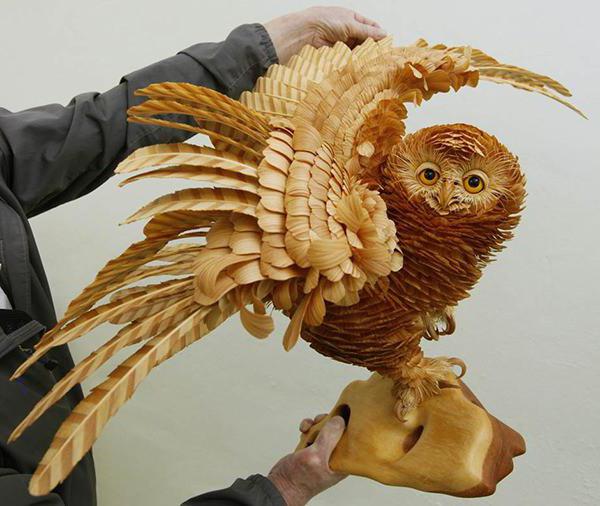 This method of processing wood allows you to create three-dimensional images without a background - sculptures that can be viewed from all sides. The technique is used mainly in the process of making souvenirs, toys, household items, for decorating the interior.
This method of processing wood allows you to create three-dimensional images without a background - sculptures that can be viewed from all sides. The technique is used mainly in the process of making souvenirs, toys, household items, for decorating the interior.
Plane thread
A distinctive feature of this type of wood processing is the application of an ornament on a flat surface. Depending on the nature of the pattern, this can be a flat carving, that is, the pattern is displayed in the form of recesses, recesses, and flat-relief, when the ornament protrudes above the surface. 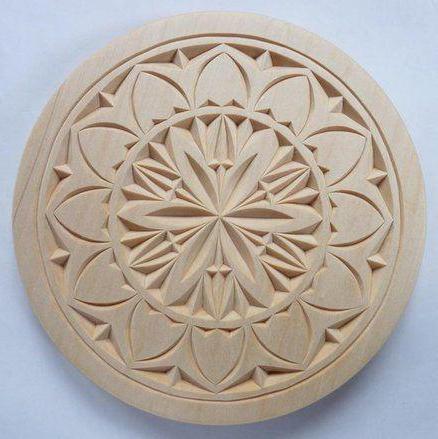 Each of these types is divided into several subspecies, among which there is also a flat-shaped geometric carving. This type is one of the simplest. It has long been used in the decoration of various household utensils with a flat surface: cutting boards, wooden utensils, furniture. Of the tools, only a joint knife is used, and geometric shapes are used as a pattern: a square, a rhombus, a triangle, a circle, an oval, and their combinations. Interestingly, in ancient times, geometric carving was not used as a simple decoration. Each element was symbolic, served as a talisman.
Each of these types is divided into several subspecies, among which there is also a flat-shaped geometric carving. This type is one of the simplest. It has long been used in the decoration of various household utensils with a flat surface: cutting boards, wooden utensils, furniture. Of the tools, only a joint knife is used, and geometric shapes are used as a pattern: a square, a rhombus, a triangle, a circle, an oval, and their combinations. Interestingly, in ancient times, geometric carving was not used as a simple decoration. Each element was symbolic, served as a talisman.
So, we examined the main types of woodcarving. Of course, this is the material of more than one article. And not even one book. The experience of masters has been passed down from generation to generation for many centuries. Something, unfortunately, has been lost, but something has been preserved, changed and developed into a new industry. And this is already a good sign. He proves once again that this decorative arts continues to develop. And today it is no less popular than a few centuries ago.











How to understand: will the kitten be fluffy?
What kind of light alcohol can be drunk for pregnant women: the consequences of drinking
Why do the legs swell in the ankles and ankles of the feet in pregnant women: causes and methods of treatment
The wedding of Prince Harry and Meghan Markle: scandalous and secret details of the marriage (photo) The future marriage of Prince Harry year NTV
How to close white plums for the winter